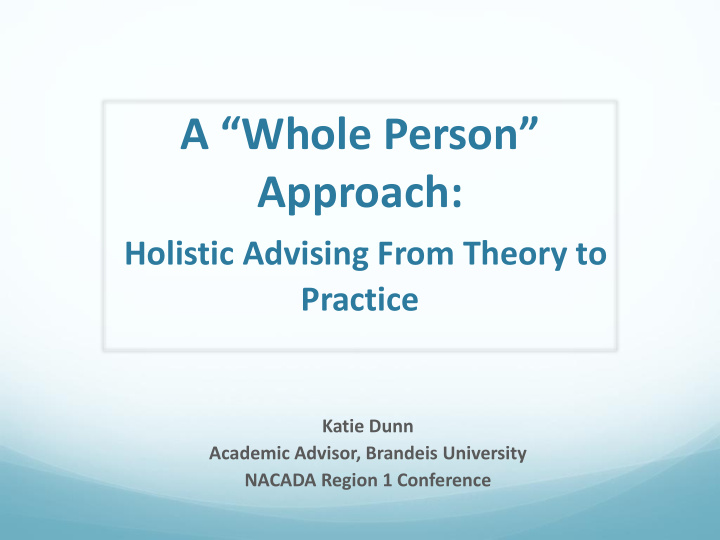



A “Whole Person” Approach: Holistic Advising From Theory to Practice Katie Dunn Academic Advisor, Brandeis University NACADA Region 1 Conference
What non-academic topics are you hesitant to discuss with students?
What non-academic topics have you seen impact a student’s academic performance?
This is why we are having this discussion!
Goals for today Define holistic advising Describe best practices of holistic advisors Acknowledge challenges holistic advisors face Understand and apply theoretical frameworks to holistic advising practice and student cases Justify the value of holistic advising within your role on campus
A familiar reality... “We’ve become parts of people relating to parts of people”
Holistic Advising Defined Holistic advising is a developmental process that focuses on the whole student, taking into consideration all the complexities of a person . - Hamline University, St. Paul, MN Holistic advising is something we work at!
Holistic Advisors … Act as navigators • We’re often a primary staff contact for students • We can help students make sense of the “hidden curriculum” of college • We don’t need to provide an exact “road map” but can offer pathways to solve a problem or reach a destination Avoid sending students on a wild goose chase!
Holistic Advisors … Shift student expectations “I just need a minute, will you sign this form for me?” “I’ve picked my classes, so what else is there for us to talk about? “Could we do a 4 -year- plan?” “There are so many options: I want to choose the right one!” “This policy is so unfair! Can you make an exception?” “What paperwork do I need to do to transfer? This school just isn’t a good fit.” Holistic advisors take the opportunity to What are the expectations communicated? challenge and reframe student expectations in an appointment.
Holistic Advisors … Consider Intersectionality When have two of a student’s social identities impacted their academic experience? How did this inform your work with them?
Holistic Advisors … Network across campus How well do you know your campus partners? Location and purpose of office How students can initiate contact Basic website information Staff Relationships What offices on campus do you often refer students to but know little about?
Holistic Advisors … Go the extra mile! Use proactive advising to your advantage Regular and follow up meetings Faculty Queries Keep a “watch list” Utilize peer mentors Partner with residence life or dean of students Use non-email modes of communication What other proactive strategies do you use?
Challenges To Holistic Advisors Time/Caseload size May always feel like you are “trying to stay afloat” Maintaining Healthy Boundaries Students may think of you as a “one stop shop” and not connect with other faculty/staff Can sometimes cross the line from empowering to enabling students Institutional Culture May have constraints on your role and frequency of collaboration
Two frameworks I use as a holistic advisor Jesuit Education Tinto’s Theory of Student Departure
Disclaimer
Jesuit Education Academic Integration Integration Student Social Vocational Formation Integration Integration Spiritual
Advising takeaways Advisors have a responsibility to promote integration along all dimensions of student formation. Advisors can act as “conversation partners,” helping students pay attention to, reflect on and make meaning of the formative experiences of college. Advisors can encourage students to seek their deepest desires and find their vocation in the world.
Tinto’s Retention Theory Source: Yorke, M. (2013). Student retention in open and distance learning.
Advising Takeaways Advisors should get to know students’ pre-entry characteristics, goals and needs as thoroughly as possible to offer targeted resources and support. Advisors should work to identify the cognitive and non-cognitive strengths students bring to college. Advisors can facilitate connectedness by working with students to address academic and social challenges utilizing their strengths and resources.
Case Studies! What would be your approach to working with this student? Share ideas from what you’ve learned today and best practices from your own experience.
Final Thoughts and Reflection
Questions? Thank You!
Recommend
More recommend